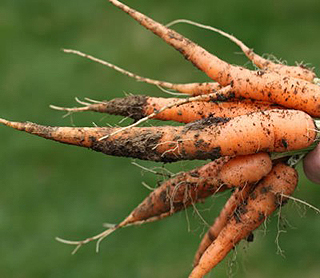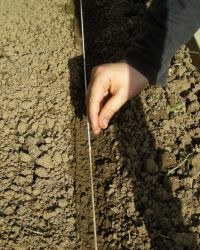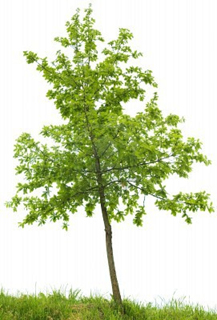 Having bought three different types of carrot seed my customer was about to leave the shop when he turned round and said, ’What’s the knack to growing carrots then?’ If anybody mentions carrots it makes me grin. I remember Frank coming up to the Chapel 5 or 6 years ago (he will recall the precise date of course!), he looked at my rows of carrots and was fairly dismissive of my attempts. He had grown carrots on my land for years, far more successfully and I felt he was confirming my epitaph firmly established during my school days, ‘could do better’.
Having bought three different types of carrot seed my customer was about to leave the shop when he turned round and said, ’What’s the knack to growing carrots then?’ If anybody mentions carrots it makes me grin. I remember Frank coming up to the Chapel 5 or 6 years ago (he will recall the precise date of course!), he looked at my rows of carrots and was fairly dismissive of my attempts. He had grown carrots on my land for years, far more successfully and I felt he was confirming my epitaph firmly established during my school days, ‘could do better’.
So last year, as the subject is seemingly often raised, I decided to do some serious research. I would not blindly sow in mid March for early carrots but discover what the best brains say. Thank heavens for the internet when serious research needs doing. Because open up Google and there is so much about growing a successful carrot crop you wonder how you ever managed before. I have grown reasonable carrots because I did what my Dad did, as so many of us do. But I do remember Mum spending hours weeding and thinning carrots and it never looked much fun to me.
So the first element to consider is the soil. If you have heavy clay or stony soil it has to be improved, otherwise the root cannot get down and will be stunted, stubby or forked. It causes great mirth on lifting and will be a prize winning entry in the ‘unusually shaped vegetable’ category in the show, but if you are the one preparing it for the kitchen it’s not quite so amusing. A fine sandy or loamy tilth is perfect, allowing the root to extend downwards in a straight line. If you are going to hit rock with the longer varieties of carrot then try a shorter rooted fatter variety or grow a few in pots. Ideally good garden compost or manure should have been added in the autumn. If you put on too much of the good stuff now then you will get fabulous leaves and not too much root. A little bone meal added to the seed bed is sufficient and a ph level of around 6.5 is ideal.
If you are growing early carrots then a sunny spot is ideal, main crop can cope with a bit of shade during the hot summer we are going to have this year…
 Don’t sow seed if the soil is cold to the touch. They will germinate in cold soil but it seems to set them back weeks so just feel the soil with your hands and if it’s not cold to the touch carry on. 5 degs is ok, 10 degs is perfect.
Don’t sow seed if the soil is cold to the touch. They will germinate in cold soil but it seems to set them back weeks so just feel the soil with your hands and if it’s not cold to the touch carry on. 5 degs is ok, 10 degs is perfect.
It used to be that you formed a seed bed about .5cm deep ran your seed along and then thinned out when they all came up. For a little bit of time invested, put the seed in your left hand (v.v. if you’re left handed!) take a pinch of seed and try to spread the seed as finely as possible along the row. I manage to spread mine quite finely with the aid of my reading glasses and that reduces thinning later. Dad used to mix his seed with sand, apparently to make it easier, but I have never got the hang of that.
Now the books may tell you to water the seed bed or to water in after sowing and cover to a depth of .5cm. Bob Flowerdew mentions that you should water the seed bed the day before a sunny one, and then the seed should not have water from anywhere, including the sky, for 6 hours. That may sound like a tale but I promise you my best crops have been grown by applying this Flowerdew magic and I am sticking to it because it works for me. Having said that, once they are growing, carrots need water during the growing season.
 When they all come up in thick bunches because you did not take the time to sow them finely then thinning out is a must if you want large carrots. The thinnings can be eaten and are so sweet. Pull out enough to give room for the remaining roots to swell but try and do it in the evening. (Ideally the middle of the night.) The carrot fly will smell the thinnings, it is attracted to the leaf smell as you waft them about, but it is only around during the day. (Don’t ask, no, I don’t know where carrot flies go at night!) Firm in any loose soil around the remaining plants because that is where it likes to lay its eggs which turn into yellow maggots which eat your crop. If you are plagued by carrot fly you can cover with a fleece or surround the crop with it. They are low flyers so a barrier will stop them invading. So far, I have never had carrot fly and I think that’s because we are so high they cannot fly up here, preferring the low lying village!
When they all come up in thick bunches because you did not take the time to sow them finely then thinning out is a must if you want large carrots. The thinnings can be eaten and are so sweet. Pull out enough to give room for the remaining roots to swell but try and do it in the evening. (Ideally the middle of the night.) The carrot fly will smell the thinnings, it is attracted to the leaf smell as you waft them about, but it is only around during the day. (Don’t ask, no, I don’t know where carrot flies go at night!) Firm in any loose soil around the remaining plants because that is where it likes to lay its eggs which turn into yellow maggots which eat your crop. If you are plagued by carrot fly you can cover with a fleece or surround the crop with it. They are low flyers so a barrier will stop them invading. So far, I have never had carrot fly and I think that’s because we are so high they cannot fly up here, preferring the low lying village!
It is also true for me that if you grow carrots next to onions or even alternate the rows, the carrot fly is deterred by the competing odours.
 Now, on April 3rd we will have been at the Chapel for 11 years. The garden and the Nursery were established on a piece of flat pasture and it has not taken long to mature. We have planted trees of various sorts to protect us from the south westerly winds and all the shrubs are now showing their gratitude. From my office window I can see 17 cordyline, the tallest about 17ft and 4 silver birch with the peeled brown bark. I am not sure why we planted four. The tale goes you should plant birches in threes to keep the witches away, no doubt we will confuse them if nothing else. Further, 6 eucalyptus at over 20 ft tall, an acacia pravissima arching over the patio and covered in yellow flowers at 10ft tall, two super producing apple trees and the pinus radiata pines that throw out magnificent lime green new growth and cones. But we were reminded this week to inspect our oak tree.
Now, on April 3rd we will have been at the Chapel for 11 years. The garden and the Nursery were established on a piece of flat pasture and it has not taken long to mature. We have planted trees of various sorts to protect us from the south westerly winds and all the shrubs are now showing their gratitude. From my office window I can see 17 cordyline, the tallest about 17ft and 4 silver birch with the peeled brown bark. I am not sure why we planted four. The tale goes you should plant birches in threes to keep the witches away, no doubt we will confuse them if nothing else. Further, 6 eucalyptus at over 20 ft tall, an acacia pravissima arching over the patio and covered in yellow flowers at 10ft tall, two super producing apple trees and the pinus radiata pines that throw out magnificent lime green new growth and cones. But we were reminded this week to inspect our oak tree.
They often do not grow brilliantly in the Cornish winds but we tucked this one away at the bottom of the garden away from the winds and he has grown to about 6 ft in only 5 years. We were reminded of him because we delivered three 6ft oaks to a friend in St Erme who wanted them for the bottom of his garden. When I got there I could see that he was filling in a gap next to three mature oaks that could be over 100 years old. ‘I won’t see them mature’ he said, ‘I am almost as old as the other three, but these are being planted so that future generations can enjoy the view that I have enjoyed for much of my life.’ I was profoundly struck by the legacy he is leaving and felt moved to plant another one here quickly. If everybody planted a tree in their lifetime what a legacy we could all leave. And that’s why we have been thinning the woodland above Veryan, a long over due task, and looking at our options for further planting of trees that will be hopefully resistant to the current diseases that are prevalent but that are native.
And finally, I have to say that I upset one of our regular readers last month. On principle I cannot retract my firm belief in growing your own veg. But I walked into the New Inn for a quiet Sunday drink to be confronted by our local veg stall holder and grower, furiously gesticulating and suggesting that encouraging locals to grow their own is not good for business! Oops! Perhaps he doesn’t grow carrots but will know how to now!!
